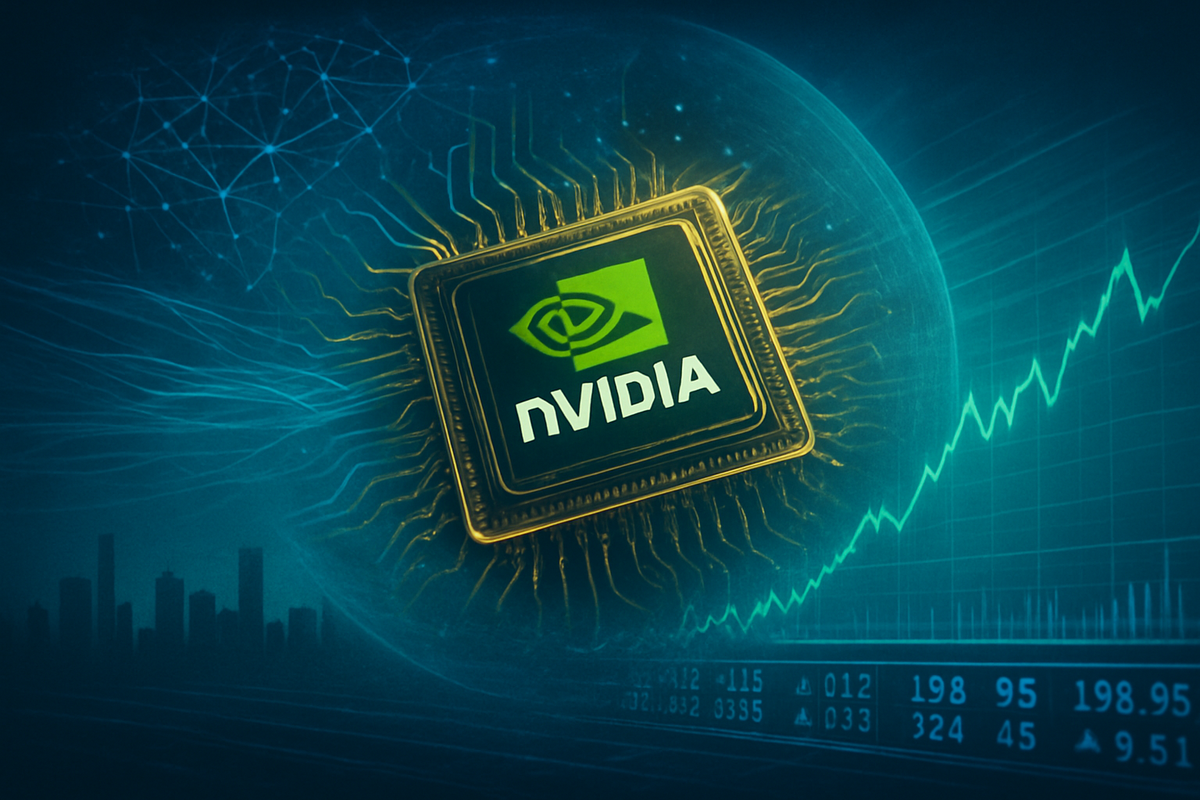
Nvidia's (NASDAQ: NVDA) recent stock performance has been a whirlwind of soaring highs and sharp corrections, acting as a potent barometer for the broader Wall Street landscape as of November 11, 2025. The chip giant, a foundational pillar of the artificial intelligence (AI) revolution, has seen its immense market capitalization—briefly cresting $5 trillion—render its every significant movement into a market-wide event, directly influencing major indices and sparking intense debate over the sustainability of the "AI bubble." This volatility underscores the concentrated power of a single tech behemoth to dictate market sentiment and investor confidence in a rapidly evolving technological era.
The immediate implications of Nvidia's gyrations have been profound. A substantial downturn earlier in the week, seeing the stock plummet over 16% by November 7th and shedding roughly $800 billion in market value, triggered widespread concerns about "valuation fatigue" in the AI sector. Yet, a robust rebound on November 10th, with Nvidia's shares surging 5.79%, single-handedly lifted the S&P 500 and Nasdaq Composite, demonstrating its unparalleled influence. The subsequent dip on November 11th, partly fueled by news of SoftBank Group Corp.'s (TYO: 9984) stake sale and poor earnings from CoreWeave (NASDAQ: CRWV), once again served as a drag, illustrating how deeply intertwined Nvidia's fate is with the overall market's daily trajectory.
Unpacking Nvidia's Meteoric Rise and Recent Market Swings
Nvidia's journey to becoming one of the world's most valuable companies has been nothing short of extraordinary, primarily propelled by its dominant position in the artificial intelligence (AI) chip market. Following a challenging 2022, the company experienced a "vigorous revival" in 2023, with shares soaring over 230%, fueled by the burgeoning demand for its H100 GPUs. This momentum continued robustly into 2024, seeing shares surge another 170% and AI chip sales accounting for over 70% of the total market share. By July 2025, Nvidia reached a $4 trillion market capitalization, further ascending to a historic $5 trillion in late October 2025, achieving an all-time high closing stock price of $207.04 on October 29th. As of November 11, 2025, the stock trades around $192-$199, maintaining a year-to-date gain nearing 44%.
The timeline leading to this moment is punctuated by key events and strategic moves. The AI boom ignited in late 2022 with generative AI applications like ChatGPT, dramatically increasing demand for Nvidia's high-performance GPUs. In November 2024, Nvidia reported strong Q3 FY2025 earnings, though a "lackluster" outlook for Q4 caused a slight initial dip. Early to mid-2025 saw the shipment of 13,000 samples of its next-generation Blackwell systems to customers like OpenAI, but also a March dip due to concerns over the Blackwell transition and potential further export limits to China. In May 2025, Nvidia warned of an $8 billion impact from ongoing China export restrictions. The company also announced a $2 billion investment in Elon Musk's xAI in October 2025 and received U.S. approval for high-end AI chip exports to the UAE. However, the sale of SoftBank's entire 32.1 million share stake in October for $5.8 billion, along with CEO Jensen Huang's controversial statements in early November regarding China's potential to "win the AI race," added to market jitters.
Key players and stakeholders in this narrative include Jensen Huang, Nvidia's CEO and co-founder, whose vision and public statements significantly sway market sentiment. Major institutional investors such as Vanguard Group Inc., BlackRock Inc. (NYSE: BLK), Fidelity Management & Research (FMR LLC), and State Street Corp. (NYSE: STT) collectively own approximately 70% of Nvidia's stock. Competitors like Advanced Micro Devices (NASDAQ: AMD) and Intel (NASDAQ: INTC) are constantly vying for market share, while hyperscale cloud providers such as Microsoft (NASDAQ: MSFT) (Azure), Amazon (NASDAQ: AMZN) (AWS), and Alphabet (NASDAQ: GOOGL) (Google Cloud Platform) are both Nvidia's largest customers and, increasingly, developers of their own in-house AI chips. Governments, particularly the U.S. and China, also play a critical role through export controls and market access policies. Initial market reactions have largely been characterized by "AI Gold Rush Enthusiasm" and "Beat and Raise" expectations, though the market has shown increasing sensitivity to forward guidance and geopolitical developments, often leading to dips even after strong earnings if the outlook is cautious.
The Ripple Effect: Winners and Losers in Nvidia's Wake
Nvidia's unparalleled dominance in the AI chip market creates a powerful ripple effect, delineating clear winners and companies facing significant challenges across the semiconductor, AI, and broader tech sectors. Nvidia's stock returned over 240% from January 2024 to January 2025, and as of November 11, 2025, its approximately $4.8 trillion market capitalization represents 8.5% of the S&P 500 index, underscoring its systemic importance.
Potential Winners: Nvidia's success largely benefits its supply chain and partners leveraging its technology. Taiwan Semiconductor Manufacturing Company (TSMC) (NYSE: TSM) is a primary beneficiary, as Nvidia's "fabless" model means TSMC manufactures most of its advanced chips, securing an estimated 60-70% of TSMC's advanced CoWoS packaging capacity. Other semiconductor companies like Broadcom Inc. (NASDAQ: AVGO), providing networking solutions for data centers, and High Bandwidth Memory (HBM) manufacturers such as SK Hynix (KRX: 000660) and Samsung (KRX: 005930), are crucial suppliers seeing boosted demand. Electronic Design Automation (EDA) vendors like Cadence and Synopsys also gain from Nvidia's AI-driven chip design. In the AI sector, hyperscale cloud providers—Microsoft (Azure), Amazon (AWS), Alphabet (Google Cloud Platform), and Oracle (NYSE: ORCL)—are massive purchasers of Nvidia's GPUs, integrating them to power their AI services, accounting for over 50% of Nvidia's data center revenue. Specialized AI cloud providers like CoreWeave (NASDAQ: CRWV), which has a $6.3 billion agreement granting Nvidia priority access to its cloud capacity, are also pivotal partners. AI software and application developers, including OpenAI, Iqvia (NYSE: IQV), Illumina (NASDAQ: ILMN), and Recursion Pharmaceuticals (NASDAQ: RXRX), heavily rely on Nvidia's GPUs. Beyond core tech, automotive giants like General Motors (NYSE: GM), Hyundai Motor Group, Mercedes-Benz, and Toyota (NYSE: TM) leverage Nvidia's platforms for autonomous driving and factory automation, while telecom players like Cisco Systems (NASDAQ: CSCO) and Deutsche Telekom (XTRA: DTE) collaborate on AI-ready networks.
Potential Losers (or Companies Facing Challenges): Nvidia's dominance creates intense competitive pressure. Advanced Micro Devices (AMD) (NASDAQ: AMD) is Nvidia's primary competitor in GPUs and AI accelerators, but despite progress with its Instinct MI300X chips, Nvidia maintains over 80% of the AI training market share. AMD has also highlighted Nvidia's recent investment in Intel as a risk, potentially leading to "increased competition and pricing pressure." Intel (NASDAQ: INTC), despite its long history, has struggled to gain significant traction in the dedicated AI GPU market, holding less than 1% of the add-on GPU segment. Smaller AI chip startups face an uphill battle against Nvidia's established ecosystem and scale. While hyperscale cloud providers are major customers, they are also developing their own in-house AI accelerators (e.g., Google's TPU, Amazon's Trainium, Microsoft's Maia) to reduce reliance on Nvidia, posing a long-term indirect competitive threat. Furthermore, businesses unable to afford or effectively integrate Nvidia's cutting-edge AI technologies risk falling behind competitors who can leverage these advancements.
Wider Significance: Reshaping Industries and Inviting Scrutiny
Nvidia's pervasive influence transcends mere market capitalization; it represents a fundamental reshaping of industry trends, a redefinition of competitive landscapes, and a magnet for regulatory scrutiny. At its core, Nvidia's dominance is inextricably linked to the broader AI and semiconductor industries, where its Graphics Processing Units (GPUs) and the proprietary Compute Unified Device Architecture (CUDA) platform have become the de facto standards for AI development. Commanding an estimated 70% to 95% of the market for AI training chips and over 90% of the data center GPU market, Nvidia is the indispensable backbone for training large language models (LLMs) and neural networks across virtually all major tech companies. The CUDA ecosystem, with its maturity and seamless integration with AI frameworks like PyTorch and TensorFlow, creates a formidable "moat" that fosters significant vendor lock-in, making it costly and disruptive for customers to switch to alternative solutions.
The ripple effects on competitors are substantial. Rivals like AMD (NASDAQ: AMD) and Intel (NASDAQ: INTC) face immense pressure to innovate and develop equally robust and developer-friendly software platforms to challenge CUDA. Despite efforts with platforms like AMD's ROCm and Intel's oneAPI, they often struggle with fragmentation and lack the unified API support of CUDA. While AMD has seen some success with its Instinct MI300X chips, it still holds a fraction of Nvidia's market share in AI accelerators. For partners, particularly cloud service providers, their deep reliance on Nvidia's technology entrenches its role as a critical enabler, even as some begin to explore or develop custom AI accelerators to mitigate this dependence. The concentration of power among a few key technology providers, with over 50% of Nvidia's data center revenue coming from just three unnamed customers, also highlights a potential concentration risk.
Nvidia's market dominance has not gone unnoticed by regulators. The U.S. Department of Justice (DOJ) is reportedly investigating Nvidia for potential antitrust violations, probing complaints of illegal tying agreements and actions that could stifle competition, particularly focusing on the "vendor lock-in" enabled by CUDA. Beyond the U.S., French authorities are reportedly preparing to charge Nvidia for breaking competition laws, and the European Union's digital sovereignty agenda could indirectly pressure the company. Geopolitical factors, especially U.S. export controls on advanced semiconductors to China, pose significant regulatory challenges, impacting Nvidia's market access and revenue streams, with projections suggesting its market share in China could decline significantly, potentially to zero.
Historically, Nvidia's concentrated market influence draws parallels to Intel's (NASDAQ: INTC) indispensable position in CPUs during the PC era. It also evokes memories of market exuberance during the Dot-Com Boom and Bust (late 1990s - early 2000s) and the "Tronics Boom" of the early 1960s, where investor enthusiasm for new technologies led to speculative bubbles. While these serve as cautionary tales regarding market speculation, they also underscore the transformative power of genuine innovation and critical infrastructure. Just as the telegraph or stock ticker revolutionized information dissemination in earlier markets, Nvidia's AI chips are fundamentally reshaping modern industries. The long-term viability of such a dominant player, while driving innovation, often hinges on its ability to navigate increasing competitive pressures, geopolitical risks, and potential antitrust actions.
What Comes Next: Navigating the Future of AI and Beyond
Nvidia stands at a pivotal juncture, poised to continue its leadership in the AI revolution while navigating a complex landscape of opportunities and challenges. The company's recent performance in 2024 and 2025 has been characterized by explosive growth, consistently beating sales and earnings targets. Nvidia's Q3 FY2025 revenue hit $35.1 billion, with data center revenue alone reaching $30.8 billion, showcasing its immense financial strength. The stock split and increased dividends in Q1 FY2025 further underscore its robust position.
In the short-term (around November 11, 2025), analysts remain overwhelmingly bullish, with "Strong Buy" ratings and average one-year price targets ranging from $217.93 to $237.35, with some projections as high as $350. Expectations are high for Nvidia's Q3 FY2026 earnings report (due November 19, 2025), with potential for another "beat and raise" scenario driven by the ramp-up of its Blackwell architecture. Approximately 3 million Blackwell chips have already shipped in 2025, signaling strong demand. However, short-term market volatility is expected due to macroeconomic pressures, geopolitical developments (U.S. export controls impacting China sales, leading to significant revenue loss and increased GPU prices), and intensifying competition from local Chinese AI startups and hyperscalers developing in-house chips.
Long-term (2025-2030), Nvidia's prospects remain highly optimistic. The broader AI market is projected to grow at an astounding compound annual growth rate (CAGR) of 36.6% from 2024 to 2030, presenting vast opportunities. Long-term price targets for Nvidia's stock range from $217.20 to $506.80 by 2030, with some algorithmic models projecting averages exceeding $900 and highs over $1000. Nvidia is strategically diversifying beyond core GPU sales into full-stack AI platforms, networking, "AI factory" construction, and AI-as-a-service. Significant growth opportunities are identified in autonomous driving (via the Nvidia DRIVE platform), the Internet of Things (IoT), and digital-twin technology (Omniverse), with the company highly optimistic about the "robotics era." Sovereign AI initiatives by governments globally are also expected to generate substantial revenue. Continuous innovation, with upcoming Rubin (2026) and Rubin Ultra (2027) GPU architectures, will be crucial for maintaining its competitive edge.
To sustain its leadership, Nvidia is undertaking several strategic pivots and adaptations. This includes a greater focus on full-stack AI solutions and enterprise-grade AI software suites, aiming for recurring revenue streams. While its proprietary CUDA platform is a strength, some analysts suggest that embracing more open platforms could be beneficial given the rise of alternatives like AMD's ROCm. Collaborating more aggressively with hyperscalers for custom silicon co-design acknowledges their increasing desire for self-sufficiency. Geographically, de-risking from a heavy reliance on the Chinese market due to trade restrictions, and expanding into other high-growth regions like the Middle East, is vital. Furthermore, intensifying focus on emerging sectors like reasoning AI and physical AI, as evidenced by the Llama Nemotron models and Blackwell Ultra platform, will be key.
Market opportunities include persistent and massive investments in AI infrastructure, the widespread adoption of generative AI, and the growth of AI inference revenue (now over 40% of data center revenue). However, challenges persist, such as intensifying competition from AMD (NASDAQ: AMD), Intel (NASDAQ: INTC), and hyperscalers, ongoing geopolitical tensions, valuation concerns about a potential "AI bubble" (with a "trough of disillusionment" potentially in late 2026 or early 2027), and potential market saturation or moderation of growth. Supply chain vulnerabilities due to export controls on AI chip materials also remain a risk.
Considering these factors, potential scenarios and outcomes around November 11, 2025, range from an optimistic scenario where Nvidia significantly surpasses earnings, its strategic pivots gain traction, and its stock approaches higher analyst targets, to a pessimistic scenario where disappointing earnings or guidance, increased competition, or a broader slowdown in AI spending trigger a market correction and stock pullback. A baseline/moderate scenario sees robust but normalized growth, with manageable headwinds and steady progress on strategic pivots. Nvidia's trajectory will continue to be a significant bellwether for the broader technology sector.
A New Era of Influence: Charting the Path Forward
Nvidia's recent market performance and its profound influence on broader Wall Street gains and losses underscore a pivotal moment in financial history, highlighting the unprecedented power of a single technology company to shape global market dynamics. The key takeaway is clear: Nvidia (NASDAQ: NVDA) is not merely a component supplier; it is the architect of the AI era, with its GPUs and the CUDA ecosystem forming the indispensable foundation upon which the future of artificial intelligence is being built. Its explosive growth, record revenues, and historic market capitalization milestones in 2025 attest to its technological leadership and market dominance, even as it navigates complex geopolitical headwinds and intensifying competition.
Moving forward, the market will continue to be heavily influenced by Nvidia's trajectory. The insatiable demand for AI infrastructure from hyperscale cloud providers like Microsoft (NASDAQ: MSFT), Amazon (NASDAQ: AMZN), and Alphabet (NASDAQ: GOOGL), coupled with Nvidia's strategic expansion into full-stack AI solutions, autonomous vehicles, robotics, and sovereign AI initiatives, points to a sustained high-growth path. However, this growth will not be without its challenges. The rising tide of competition from rivals such as AMD (NASDAQ: AMD) and Intel (NASDAQ: INTC), alongside the increasing trend of major customers developing their own in-house AI chips, will test Nvidia's ability to maintain its commanding market share and pricing power. Regulatory scrutiny over its market dominance and the enduring complexities of U.S.-China trade relations regarding advanced semiconductors will also remain critical factors.
The lasting impact of Nvidia's reign will be its role in accelerating the AI revolution, fundamentally transforming industries from healthcare to automotive and beyond. Its innovations are not just about faster chips; they are about enabling new frontiers of scientific discovery, economic productivity, and human-computer interaction. Investors in the coming months should closely monitor Nvidia's upcoming Q3 FY2026 earnings report (November 19, 2025) for insights into its financial health and forward guidance. The continued ramp-up and demand for its Blackwell GPUs, the competitive landscape with new offerings from rivals, and any shifts in geopolitical policies affecting its international sales will be crucial indicators. Furthermore, observing the success of its diversification strategies beyond core data center business and any potential pressures on its impressive gross margins will provide a comprehensive view of its long-term viability. Nvidia's journey will undoubtedly continue to be a bellwether for the broader technology sector, offering both immense opportunities and significant challenges in the unfolding AI-driven future.
This content is intended for informational purposes only and is not financial advice







